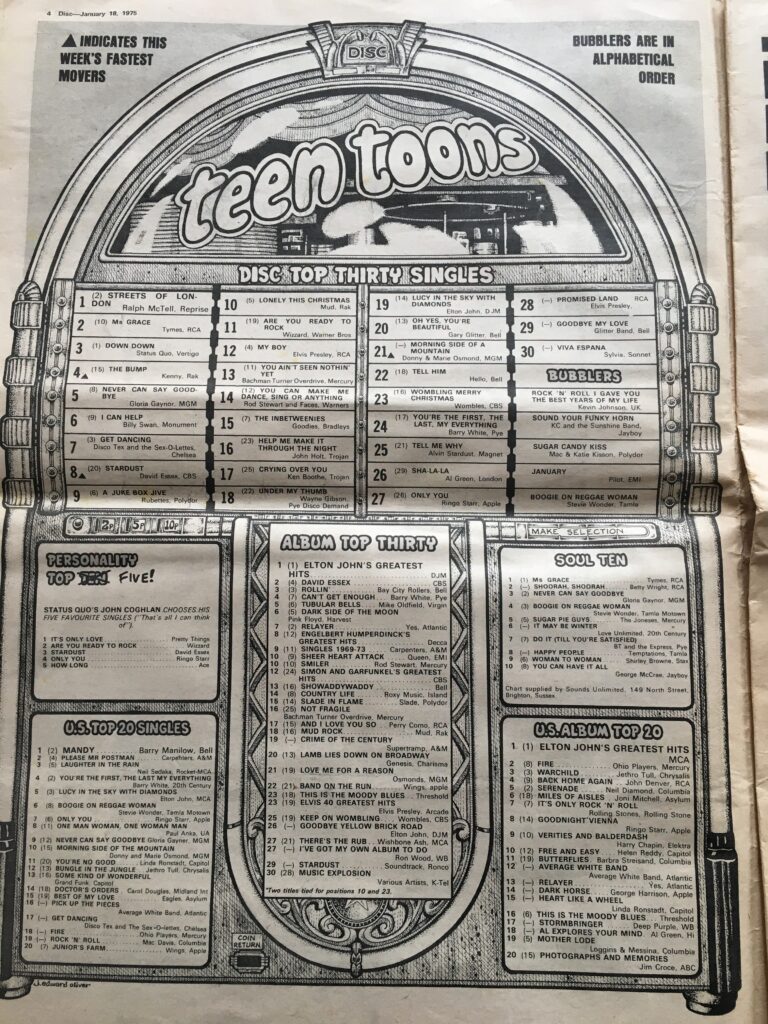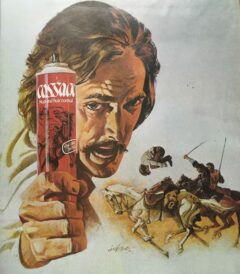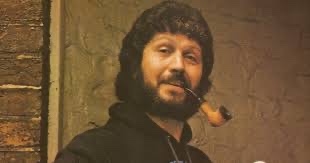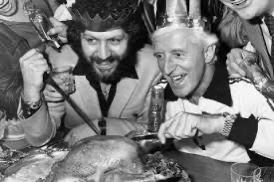The singles charts are no more but is this a good thing?
The way we listen to music now has changed in a way no one could have imagined 30 years ago. Spotify, Deezer, Youtube and iPod were just fantasies in a mad science fiction writer’s crazed mind. To sit down at a small computer and, within seconds, start listening to a piece of music you hadn’t previously possessed is mind-blowing to someone like me who grew up in the 60s and 70s and listened to music in a way that is now completely obsolete. And I actually miss this anti-diluvian system of music consumption in many ways but, although, deep down, I know that the revolution has been good for music fans in so many unimaginable ways (maybe not so much for artists), I miss hugely that fulcrum of musical information, the nexus of any week’s pop knowledge, that perennial pivot of pop power, the weekly singles and album charts.
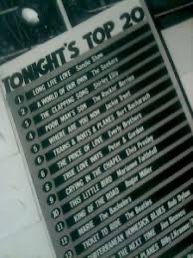
Now I know charts still exist and are probably still issued weekly by some anonymous data company somewhere and are based partly on record sales (although who buys new music from a shop nowadays?) but, more importantly, ‘downloads.’ Any young person looking at these charts will get an idea of who’s hot and who’s not at the time, but nothing like in the same way we did 30 or 40 years ago. To a music and knowledge obsessed teenager like myself (who couldn’t get a girlfriend), the charts were pure gold in so many ways and guaranteed, literally, hours of analysis, interpretation, scrutiny and downright, old-fashioned enjoyment. And why was this? Read on if you’re not already mindnumbingly bored by the subject…….
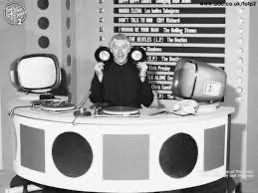
In the 1950s singles were really just a way of publicising an artist’s new album by releasing a single track from it. Someone somewhere had the genius idea of compiling a chart of the best sellers and the record industry never looked back. It tapped into a youth market that maybe couldn’t afford to buy albums and a whole new musical culture was created. The element of competition between artist, the emerging fan bases, the ease by which many groups and singers could more easily get themselves known and the developing TV and radio mediums all aligned at the same time to give birth to the institution they called The Hit Parade. We all knew they were manipulated, tampered with and generally orchestrated by the record companies but we didn’t really care. The singles charts were here to stay! (for a long time at least…)
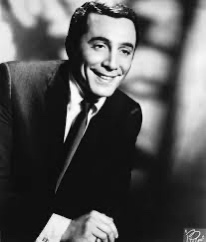
My first recollection of the singles charts was in 1967. We had a brown and white Bakelite radio that my mum would listen to in the morning to what was the forerunner of Radio 1, The Light Programme. She loved a record by Anita Harris (a 60s and 70s variety stalwart and still very much with us!) that was played quite regularly called Just Loving You and I remember very clearly how excited she got when she heard it had got to number 30 in the charts. To me number 30 seemed nothing special but in later years I realised getting into the top 30 meant selling a shitload of records, thousands in fact, unlike today when you can get to number 1 by getting a dozen downloads. Anita Harris eventually got to a nose-bleed- inducing number 6 and spent a staggering 30 weeks in the top 50. That was the moment I knew there was much more to the charts than met the eye. A few months later I began to take more notice of what was being played on the wireless and have a vivid memory of absolutely loving Hole In My Shoe by Traffic. My passion for weirdness and psychedelia in music was well and truly inspired from this moment.
There were three things to look forward to every week at the age of about 15. The first was Friday at 4.00pm when school finished and the whole weekend stretched before us, secondly, Saturday night at the youth club when I could rub shoulders with girls of my own age, none of whom were interested in me obviously and Thursday when the music papers were available in newsagents and the new updated singles, albums and US charts were published. Never has so much vital information been condensed into such a small space. The movers, the non-movers, the bubblers, the fallers, the number of weeks on the chart and the new entries. All had to be digested, analysed and assessed, which could take a while and I would read NME, Sounds and Record Mirror from cover to cover. Luckily time was something I had plenty of.
The charts sat in the middle of a triumvirate of media outlets, TV, Radio and the music press, each having an effect, although not necessarily an equal one, on the following week’s chart. Radio One, of course, had the chart rundown on a Tuesday but it was the music papers’ charts that really allowed some deep analysis to be undertaken.
As a young person in the 60s and 70s, you were severely limited as to where you could hear, not just the current hits, but any popular music at all outside of TOTP and Radio 1. You might hear a record being played on a juke box in a cafe, Blue Peter occasionally featured unthreatening bands such as Freddie and the Dreamers (see The Beatles of Uncool below) or flute-driven soft rockers Vanity Fair, you might run up a shockingly high (but mercifully unitemised) phone bill by ringing BT’s Dial-A-Disc service, a friend might show-off by playing you a current single they’d bought or you might catch someone playing a tranny in the street, but that was about it. Slim pickings to say the least and so you were at the mercy of TOTP and Radio 1 whether you liked it or not, but, at that time, you did tend to like it because you knew no better.
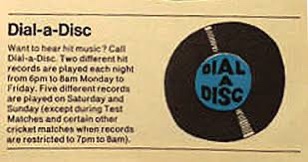
For most people it was Thursday night at around 7.00pm that allowed them to engage with the pop charts. Top of the Pops had replaced the musically and stylistically superior Ready Steady Go in the mid-sixties, purely because TOTP based their show on the pop charts and RSG just featured acts that were ‘hot.’ If you didn’t have a song in the charts, you weren’t on TOTP. And everyone knew that an appearance on TOTP would, almost certainly, have a massively beneficial effect on the artist’s disc. To be invited onto TOTP was most artist’s dream as it was often the making of them, as the majority of the millions of TV viewers every Thursday night probably didn’t listen to the radio and certainly didn’t read the music press. And although many young people who attended live TOTP shows tell a different story, the show came across on TV as vibrant, happening and exciting and everything an up and coming act would look and sound good on (despite miming). Around this time during the early 60s many young people began buying records purely on how a band or performer looked on TOTP. It was also the case that most young people, including myself, for a while believed that the charts couldn’t lie. If an act got to number one, then they must be good and they’d want to be a part of this movement of fandom and would buy the record. Of course, it didn’t take me long to understand that this was really not the case and I quickly realised Middle of the Road, Esther and Abi Ofarim, Peters and Lee, Des O’Connor or Cilla Black were neither good nor fashionable. But millions of people still bought their records!
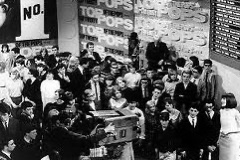
The influence on the charts of TOTP cannot be underestimated. But another huge and, I would contend, insidious influence on the singles charts was wonderful Radio 1 (See The Moronic World of 70s Radio One DJs). From its inception in 1967 it was always staffed by a bunch of guys (and it was mainly guys) who could have been our rather sleazy uncles, with a few exceptions. Throughout the 60s and 70s Radio 1 decided each week which records should be placed on their all-important ‘playlist.’ This playlist pretty much decided which records were going to be successful and which were not.
These DJs were generally selected on their ability to talk utter bollocks incessantly rather than on their musical knowledge and having an interest in or knowledge of music was not really encouraged. It was clear that the important element of most Radio 1 shows was the DJ banter between records rather than the records themselves. The music was really only there to give the DJs a breather. Of course, there were a few exceptions to this rule. The great John Peel obviously, Johnny Walker (who eventually left because he got pissed off with this culture), the virtually forgotten but excellent Stuart Henry, Kid Jensen, Paul Gambacini and Alan ‘Fluff’ Freeman with his Saturday Rock Show. Those apart, it was a litany of middle-aged guys who loved the sound of their own voices, their funny characters, amusing quizzes, hilarious jingles (What’s that Arnold?) and wacky tabloid news stories. But their influence on the singles chart was terrifyingly significant!

John Peel told a story of being invited to a party at Dave Lee Travis’s huge mansion (they all lived in ‘mansions’ apart from Radio One elf Bruno Brookes who lived in an Irish castle). The first thing Peel did when he went to someone’s house was go and have a look at their record collection. He spent some time searching from room to room before realising that DLT, the ‘Hairy Monster,’ Pipe Smoker of the Year 1982, self-styled arbiter of pop culture, possessed no records whatsoever or even a sound system. I watched one of those excellent Friday night music documentaries on BBC 4 some months ago, Charts Britannia, which showed footage of the Radio 1 panel which selected records for its playlist each week. On this panel sat a number of men and women, most over 50 and some well into their 60s and one Dave Lee Travis. It’s little wonder Peters and Lee, Cliff, Cilla and Des did so well in the charts in these days. I once saw Radio 1’s ghastly Steve Wright described in a UK tabloid as a ‘pop expert.’ That single sentence put me in a bad mood for 3 years. (See The Moronic World of 70s Radio One DJs below).
That said, the singles charts, the top 50, was an archeological dig of the good, the bad and the hideously ugly. And that’s what made them so fascinating.
The singles charts were a melange of the great, the quite good, the horrendously awful, the bizarre, the inexplicably successful, the shocking, the revelatory, the jaw-dropping weirdness, the utterly amazing and, sometimes creating a frisson of excitement, the banned. Take the following randomly selected, but musically significant, edition of the NME singles and albums chart of May 22 1976 for example. Within this mid-70s chart exists, I would argue, all the above categories of hit single but it also offers a revealing template for society at that time as every chart did to varying extents.
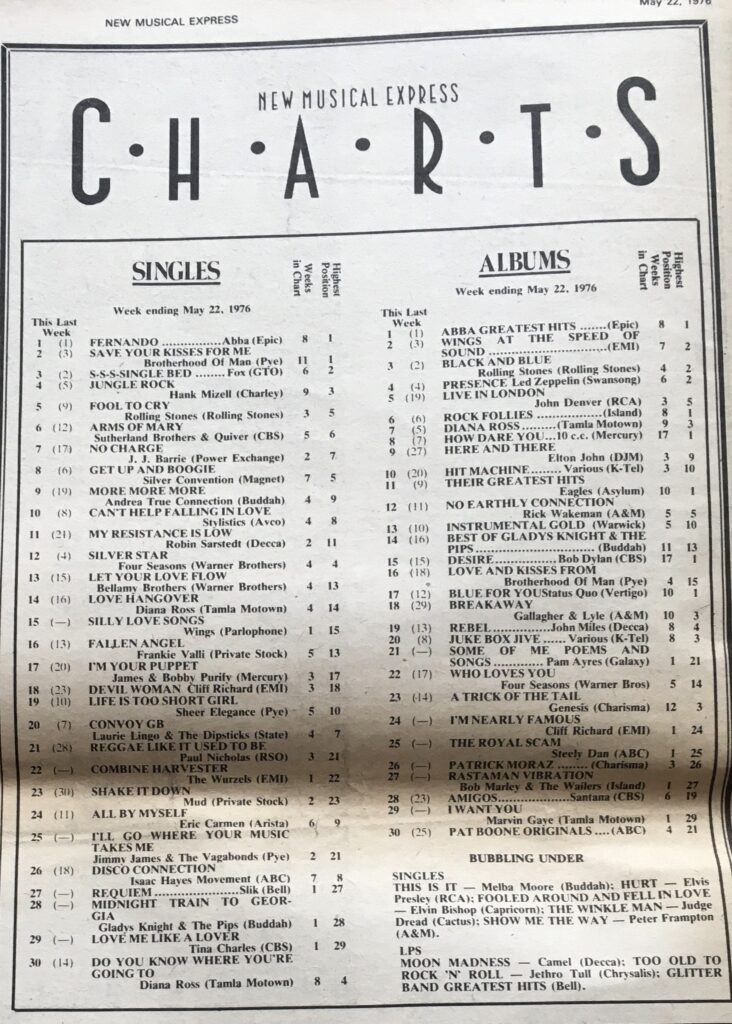
We can quickly bypass the number 1 and 2 singles as little more needs to be written about Abba, other than, as The Guardian‘s Pete Paphides observed accurately, ‘If you don’t like Abba, you don’t like pop.‘ Little also needs to be said about Abba wannabes Brotherhood of Man with their bland and irritating Euro winner Save Your Kisses For Me. But it’s the nether regions that always held the greatest interest. Have a look a little further down the top 10 and at 9, up a massive 10 places, is Andrea True Connection with the wonderful disco classic, More, More, More. For me, this was the quintessential single of that very trashy period we called the mid-70s. Now Andrea True was actually a porn star and the publicity pics for her record were a little racy, and taking the record’s lyrical content into account, this was a catchy, beautifully produced, trashy record that epitomised that era.
But if you want to know
How I really feel
Get the cameras rolling
Get the action going
Baby you know my love for you is real
Take me where you want to
Then my heart you’ll steal
In short, superb!

Remember what I said about the ‘inexplicable successes? Well check out numbers 20 to 22. On its way down from a high of 4, Convoy GB by Laurie Lingo and The Dipsticks and on its way to Number 1, Combined Harvester by The Wurzels. What have both of these records got in common? Correct.
But would you Adam and Eve it? Laurie Lingo and the Dipsticks just happened to be our old pal, the hairy cornflake, DLT and his partner in musical crime, Radio 1’s forgotten DJ (must have kept his nose clean) Paul Burnett. As a comedic parody of CW McCall‘s 1976 blockbuster Convoy, it was about as funny as a burning orphanage. And it raises the perennial question, who bought that shit and did these people actually think it was funny? Laugh? I thought I’d never start.

The Wurzels, originally Adge Cutler and The Wurzels, had appeared on the iconic 60s chat show Dee Time (See Dee Time: When The Sixties Really Began) before settling comfortably into ITV afternoon easy listening shows (the ones you watched when you’d skived off school for the afternoon) in the 70s, particularly The Great Western Music Show (I think it was called) until Adge sadly turned his sports car over in 1974 and they became The Wurzels. Combined Harvester was a parody on Melanie’s 1972 No.4 hit Brand New Key and although they may have overstayed their welcome in the charts over the next few years, this was, I suppose, a fairly decent comedy record if you liked that kind of thing.
She’s a fine looking’ woman and I can’t wait to get me ‘ands on her land…..
Interestingly, one of The Wurzels came from Penicuick, Midlothian. Fancy that!
Also falling into the embarrassingly bad and ‘how did that ever get into the charts ?‘ category, Reggae Like It Used Be by Paul Nicholas nestles in the middle of this triple decker of trash. I have written in much more detail about PN in Rubbish Songs, Inexplicable Hits section of this little blog, specifically about the even more irritating Grandma’s Party (See Rubbish Songs, Inexplicable Hits). Needless to say, this was also rubbish.
And notice within the ‘Bubblers‘ a certain Judge Dread and his latest waxing The Winkle Man, on its way to a high of No. 35. Judge Dread had 8 top 40 hits in the 70s, none of which were played on Radio 1 or TOTP. His songs were Reggae-inflected rudeness , two of his later minor hits being Up With The Cock and Y Viva Suspenders. You get the idea. Which just goes to show the record buying public loved something a little risqué, whether they had heard the record or not, and it was probably not. There was a certain type of kudos achieved by surreptitiously revealing a Judge Dread record to your pals in the same way you might by conspiratorially display a copy of Playboy from its hiding place under your bed. Up until a few months ago I had never heard a Judge Dread song. In December of 2019 I attended a Bad Manners gig in Edinburgh and in support was, believe it or not, a Judge Dread tribute act who reeled off his ‘Big’ hits from soup to nuts. He was really quite good.

Judge Dread was probably only ever outdone in the chart rudeness stakes by Ivor Biggun and The Red Nosed Burglars with their 1978 No. 22 smash, I’m A Winker, and they were very insistent that this was a misprint. Strangely, wonderful Radio 1, DLT and the septuagenarian pop panel failed to add this to the Radio 1 playlist. Turned out Ivor Biggun was Doc Cox from Esther Rantzen’s awful consumerist show, That’s Life. He couldn’t even stop himself being slightly rude on that show either, given his TV name. Mind you, they were obsessed with rude-shaped vegetables. But rudeness aside, records that were not on the Radio 1 playlist rarely made it into the charts unless they had some notoriety.
Anyone casually perusing this chart from 1976 might notice just how many MOR records peppered the top 30, songs that were written in committee as vehicles for various MOR acts. In fact, out of the top 30, well over half could be described as easy listening or middle of the road. There is nothing in this chart that is particularly threatening or might scare the horses. Brotherhood of Man, Cliff, The Stylistics (who really churned out the bland hits in the 70s), Bellamy Brothers, Sutherland Brothers and Quiver, Frankie Valli, Stylistics clones Sheer Elegance (rubbish name), the overwrought Eric Carmen and just creeping into Top 30, the lovely Tina Charles with yet another song that sounded exactly like I Love To Love. We even have a young Midge Ure and Slik encroaching into chart territory with the bombastic but certainly not fantastic Requiem. With the exception of the legendary Isaac Hayes, some interesting experimental pop from Diana Ross and a bit of ultra-smooth soul from the wonderful Gladys Knight, there is little in this chart to excite any young person with an interest in music.
But hang on a cotton-pickin’ moment! Who’s that making such an unholy row around that adjacent temporal corner? Why it’s The Sex Pistols and their punk pals! Come to save us from being smothered by marshmallow light musical blandness. Hurrah! It just takes a cursory glance at this particular chart to see that things had to change. The charts had be wrested back from the terminal Radio 1 mediocrity that controlled them, that had almost turned da kids into The Children of the Damned (and I don’t mean Dave Vanian and Rat Scabies). But that’s what the singles charts did. They provided a template for our society at any given time. And irrespective of the blandness quotient, they still provided hours of analytical fun. I would go as far as to argue that any chart from the 50s until their ostensible end in the early 90s could be analysed meaningfully either sociologically, economically, politically, musically and, of course, aesthetically, which is where the fun would really begin.

As mentioned previously in ‘Rubbish Songs, Inexplicable Hits, anyone in the public eye could have a hit record, irrespective of whether they could sing or not. There was an unpleasant Venn diagram between ‘celebrities’, Radio 1, some record companies and TOTP. When a ‘celebrity’ (a word I’ve always hated due to the implication that those people should be ‘celebrated’) was ‘hot’ someone would approach them from a smallish record company and suggest they make a single. The celebrity would, through one eye see pound signs and through the other mainstream pop coolness. How deluded they usually were. But because these bozos were well known, they could guaranteee being placed on the septuagenarian Radio 1 playlist and a spot on TOTP. If they could get that, they were made (for a short time at least)! The combination of Radio 1 playlist repetition, exposure to 20 million viewers on a Thursday night along with the TV show they were famous for was irresistible to many gullible sections of the record buying public. Hence we were subjected to the likes of:
- Telly Savalas of Kojak fame who got to No. 1 in 1975 with a shocking version of Bread’s ‘If‘
- David Soul of Starsky and Hutch who had five, that is FIVE, top 20 hits between 1976 and 1978

- Windsor Davies and Don Estelle of It Ain’t Half Hot Mum who got to No. 1 with Whispering Grass (doubt we’ll ever see that show again)
- Dennis Waterman of Minder who scored twice with I Could Be So Good For You in 1980 and the embarrassing What Are We Gonna Get ‘er Indoors in 1983
- Dick Emery who crept into the top 50 in 1973 with ‘Ooh You Are Awful’

- Russ Abbott got to a nose-bleed inducing No.7 in 1984 with the irritating Atmosphere. I remember watching TOTP when the video was premiered and I sat there waiting for something funny to happen, after about 2 minutes I realised it was serious. What a let-down.
- Radio 2 DJ Terry Wogan‘s version of The Floral Dance with the Brighouse and Rastrick Brass Band. Like Telly and Shatner he couldn’t sing so spoke the lyrics. Either way he shouldn’t have bothered.
- And the less said about Robson and Jerome, of the Soldier, Soldier military drama serial, the better. Unbelievably, they sit at No. 9 in the chart of most successful singles EVER with Unchained Melody selling an eyewatering 1.85 million copies! One of the hard and fast rules of the singles charts always was, ‘The blander the song, the bigger the hit.’ Thus, also in the top ten all-time sellers were Boney M (twice), Queen, Elton John, Wings and John Travolta and Olivia Newton-John
- During the 80s various actors from Aussie soaps Neighbours and Home and Away, in the days when those programmes were particularly popular here, tried their luck in the UK charts while the going was good for them. The vast majority being dreadful with Stefan (Paul Robinson) Dennis achieving the nadir of Aussie pop with Don’t It Make You Feel Good in 1989. But even that got to no. 16!
The charts even provided a home for sports people, particularly footballers to try their hands at something very different to kicking a ball around. For all of them (and I mean all of them), they should have stuck to putting the boot into opponents rather than into the charts. The first footballers to strike chart gold was the oddly tuxedoed 1970 England World Cup Squad who bawled out their, albeit, quite catchy tune on TOTP, Back Home. This got to number 1 probably because of its novelty value as no football team had ever featured in the charts before.

It began a trend for international teams as well as club teams to record songs which, presumably, only their own fans ever bought. Always accompanied by a video of the team japing around in the studio with ‘cans’ pressed to their ears as if they were proper pop singers. That was enough for many to creep into the charts. Probably the type of single of any genre which has the least, if any, aesthetic value. Even Boney M and Queen singles have more.
Not content with football teams trying for chart success, some individual footballers were puffed up enough to think they might have a chance of pop career. In the front row above, sandwiched between Big Jack Charlton and Alan Mullery, we see West Bromwich Albion’s striker Jeff Astle. On the strength of the EWCS smash hit he released a solo single called ‘Sweet Water‘ but he, sadly, choked on the bitter taste of failure. The single missed the charts completely, a bit like that sitter he somehow screwed past the post against Brazil a few months later. But not so Mr Kevin Keegan in 1979 when he reached number 31 with Head Over Heels in Love written by Smokie’s Chris Norman. Or Glenn Hoddle and Chris Waddle, or Glenn and Chris as they chummily wanted to be referred to, whose ‘Diamond Lights’ got to No. 12 in 1987. Probably not the worst song ever to appear on TOTP but their performance is one of those ‘watch through your fingers’ moments.

But the charts often throw up (and I chose those words carefully) such moments as these. One of the often unadmitted joys of the charts is watching a single or act you particularly dislike moving inexorably towards the top ten. The Bay City Rollers at their peak had a 14 year old me almost ripping up the music papers in disgust. When something has this effect on you it must have a lot going for it. Or when a particular favourite has a head-to-head race to get to the top spot first, such as The Sweet v Gary Glitter or Slade v David Bowie. And to spot early a single no one else had noticed edging its way up the hit parade towards Numero Uno, to have given your pals the SP on it and told them to watch this one go was hugely enjoyable. Sultans of Swing by Dire Straits in 1977 was a good example of this type of slow-burner, having been played regularly by David ‘Kid’ Jensen on his Saturday morning show on wonderful Radio 1, before anyone had even heard of Dire Straits. Or Althea and Donna’s brilliant Uptown Top Ranking which similarly slowly nosed its way up the charts after an inauspicious start. Chart moments like these proved there was a discerning record buying public out there, a public who weren’t just content to listen to Queen, Boney M or Cliff. And the singles charts highlighted such behaviour in a way that bolstered your faith in other music-loving people of all ages.
The charts also provided the basis of many in-depth discussions which wore long into the night. Did a particular band or single ever get to number 1? What was the best number 2 single ever. How many David Bowie top 30 singles can you name? Which was the most successful Motown act? How many number 1s did The Stones have? What was the weirdest single ever to get into the top 10? What was the worst number 1 ever? And in the days before you could access some of these facts on a phone, some of the debates could go on for days, even weeks. Of course, anyone with even a passing interest in the charts will remember that in 1980 Ultravox’s overblown electronic classic Vienna was kept off the top spot by Joe Dolce and Shaddap Your Face. Although I was big a fan of Ultravox, sometimes the charts didn’t lie and the best song did get to No. 1. And that’s why I loved them.
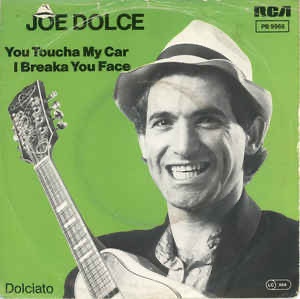
I’m told some form of singles and album charts still exists but it really isn’t the same. Music consumption is completely different today. People no longer wait with baited breath on a particular act’s new release or track its progress inexorably up and down the hit parade. Or argue with friends which particular track from a new album is the strongest single. Or feel that warm glow of satisfaction when a favourite act surpasses someone rubbish like Brotherhood of man, Bay City Rollers or Queen in the charts. But music of all genres and periods is still listened to, downloaded, streamed, pirated and, for some odd people (like myself) even played on record players. Thankfully, music is still very much alive and kicking, I’m happy to say, in its many different incarnations.
But I don’t half miss the charts…
